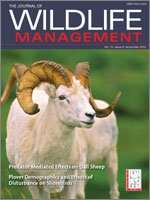We are unaware of any previous studies to evaluate using a sweep net to estimate abundance of red oak acorns (Quercus spp.) after they fall from tree crowns, sink to the ground in flooded bottomlands (i.e., sound acorns), and become potential food for animals or propagules for seedlings. We placed known numbers of white-painted red oak acorns of 3 size classes and used a sweep net to recover them in a flooded hardwood bottomland in Noxubee National Wildlife Refuge, Mississippi, USA. We recovered large acorns 1.96 and 1.32 times more often than small and medium acorns, respectively. Mean recovery rate of all marked acorns across size and density classes was 34.0 ± 7.0% (SE, n = 9). Thus, sweep-net sampling for sound acorns in flooded oak bottomlands may yield negatively biased estimates of acorn abundance, and investigators should consider using correction factors.
How to translate text using browser tools
1 November 2010
Sweep-Net Sampling Acorns in Forested Wetlands
Mitch D. Weegman,
Richard M. Kaminski,
Guiming Wang,
Michael L. Schummer,
Andrew W. Ezell,
Theodor D. Leininger
ACCESS THE FULL ARTICLE
It is not available for individual sale.
This article is only available to subscribers.
It is not available for individual sale.
It is not available for individual sale.

Journal of Wildlife Management
Vol. 74 • No. 8
November 2010
Vol. 74 • No. 8
November 2010




